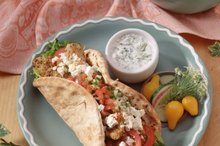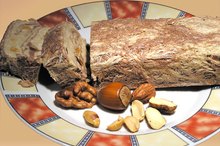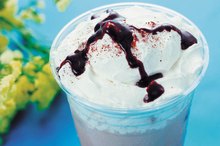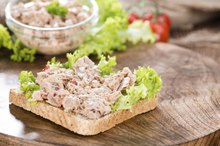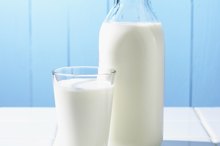What does fact checked mean?
At Healthfully, we strive to deliver objective content that is accurate and up-to-date. Our team periodically reviews articles in order to ensure content quality. The sources cited below consist of evidence from peer-reviewed journals, prominent medical organizations, academic associations, and government data.
The information contained on this site is for informational purposes only, and should not be used as a substitute for the advice of a professional health care provider. Please check with the appropriate physician regarding health questions and concerns. Although we strive to deliver accurate and up-to-date information, no guarantee to that effect is made.
How Many Calories Are in a Cup of Cooked Rhubarb With No Added Sugar?
Rhubarb is most often stewed, baked or preserved in jams or jellies. Because of its tart, acidic flavor, it is typically sweetened with sugar or honey, though doing so can more than quadruple its calorie content per serving, points out Dianne Lamb of the "Brattleboro Reformer." Without added sweeteners, cooked rhubarb is low in calories and rich in essential nutrients such as dietary fiber, potassium, vitamin C and calcium 2. Use cooked, unsweetened rhubarb as an ingredient in sauces for fish or meat, or prepare it with fruits like strawberries, apples or pears for a sweet but low-calorie topping for ice cream or in baked goods 3.
Total Calorie Content
A single cup of cooked rhubarb that includes no added sugar contains approximately 50.4 calories. According to the U.S. Department of Agriculture, this amount is roughly equivalent to the calories you would receive from consuming 1 cup of cooked chopped broccoli, 1 cup of chopped raw carrots, 1 cup of raw, peeled apple slices or 1 cup of cooked yardlong beans.
Calories from Fat
Calories in Veggie Lasagna
Learn More
Rhubarb is very low in fat: 1 cup of unsweetened cooked rhubarb provides only 4.3 calories from fat, or about 11 percent of the vegetable's total caloric content 3. Most of rhubarb's fat calories come from polyunsaturated fat -- approximately 2 of the 4.3 calories -- with a small amount also contributed by monounsaturated and saturated fat. Rhubarb does not contain any cholesterol.
Calories from Carbohydrates
A 1-cup serving of cooked rhubarb without any added sugar contains nearly 11 grams of total carbohydrates, which supply 43.6 of the 50.4 calories per cup of the vegetable. Rhubarb has 4.3 grams of fiber in each cooked cup, though fiber does not contribute any calories to the total amount. The bulk of rhubarb's carbohydrate calories is supplied by simple sugars such as fructose.
Calories from Protein
Gyro Meat Nutritional Information
Learn More
Rhubarb is low in protein, with each cup of cooked, unsweetened rhubarb containing about 2.2 grams of protein, or 8.8 calories 3. This amount is 17 percent of the caloric content of each cup of plain, cooked rhubarb. The protein in rhubarb is incomplete -- the vegetable does not provide all of the amino acids that your body requires every day. Eating a wide variety of plant products regularly can ensure that even people who don't consume any animal products can get adequate protein.
- Rhubarb is low in protein, with each cup of cooked, unsweetened rhubarb containing about 2.2 grams of protein, or 8.8 calories 3.
- The protein in rhubarb is incomplete -- the vegetable does not provide all of the amino acids that your body requires every day.
Related Articles
References
- Recipetips.com: All About Rhubarb
- Brattleboro Reformer: It's Rhubarb's Time
- Fit Day: Nutrition Info For - Rhubarb, Cooked or Canned, Unsweetened
- USDA National Nutrient Database for Standard Reference: Nutrients - Energy (Kcal); Food Groups: Fruits and Fruit Juices; Vegetables and Vegetable Products
- Rhubarb, raw. FoodData Central. U.S. Department of Agriculture. Published April 1, 2019.
- Kaczmarczyk MM, Miller MJ, Freund GG. The health benefits of dietary fiber: Beyond the usual suspects of type 2 diabetes mellitus, cardiovascular disease and colon cancer. Metabolism. 2012;61(8):1058–1066. doi:10.1016/j.metabol.2012.01.017
- Yang J, Wang HP, Zhou L, Xu CF. Effect of dietary fiber on constipation: A meta analysis. World J Gastroenterol. 2012;18(48):7378–7383. doi:10.3748/wjg.v18.i48.7378
- Kunzmann AT, Coleman HG, Huang WY, Kitahara CM, Cantwell MM, Berndt SI. Dietary fiber intake and risk of colorectal cancer and incident and recurrent adenoma in the prostate, lung, colorectal, and ovarian cancer screening trial. Am J Clin Nutr. 2015;102(4):881–890. doi:10.3945/ajcn.115.113282
- Lattimer JM, Haub MD. Effects of dietary fiber and its components on metabolic health. Nutrients. 2010;2(12):1266–1289. doi:10.3390/nu2121266
- Evert AB, Boucher JL, Cypress M, et al. Nutrition therapy recommendations for the management of adults with diabetes. Diabetes Care. 2014;37 Suppl 1:S120-43. doi:10.2337/dc14-S120
- Vitamin K. Fact Sheet for Consumers. National Institutes of Health Office of Dietary Supplements. Updated: February 24, 2020
- Rhubarb. Memorial Sloan Kettering Cancer Center. About Herbs, Botanicals & Other Products. Updated February 15, 2019
- Rhubarb. Natural Medicine Database. Therapeutic Research Center. Updated 12/18/2019
Writer Bio
Michelle Kerns writes for a variety of print and online publications and specializes in literature and science topics. She has served as a book columnist since 2008 and is a member of the National Book Critics Circle. Kerns studied English literature and neurology at UC Davis.

